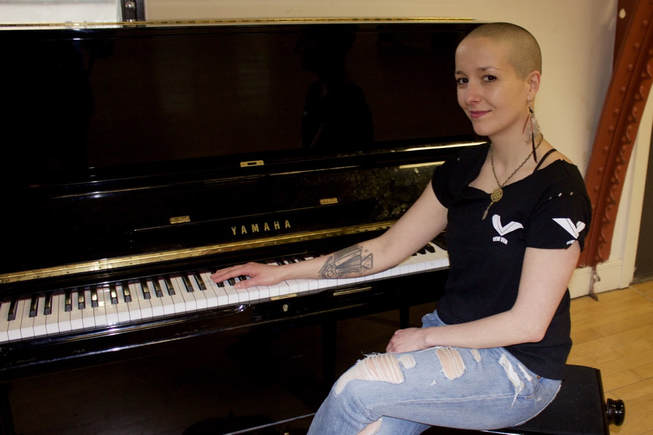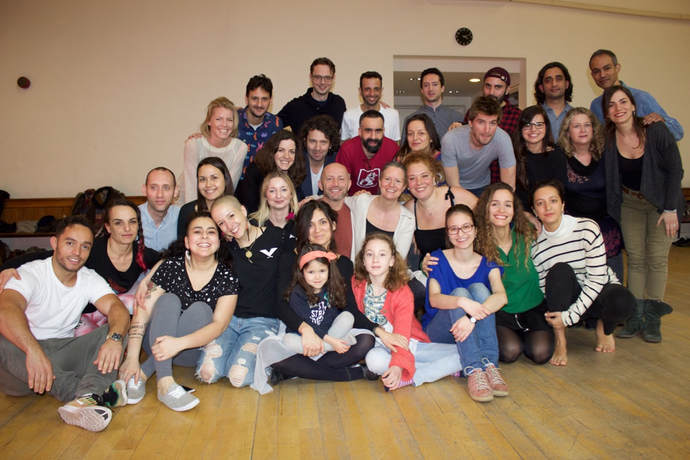|
It's a real pleasure to feature an interview with the wonderfully talented Juliana Werner who fuses contemporary dance with traditional Brazilian forró. Her partner dance classes explore “body consciousness” and challenge cultural and gender barriers in dance. But above all else, they encourage the dancer to connect first with themselves and how they want to dance: how to feel music and translate this into performance and movement. Then comes the process of connecting with your dance partner. Juliana is transplanting some of the Brazilian vibe and social aspects of dance into a more reserved British and European environment.
Juliana Werner: A few weeks ago, I received a beautiful video about my workshop at the Tabernacle on April 1st. And attached to it there was some questions that I should answer giving some information about my life and connecting it with the things I’ve been doing as an artist. And I thought, “that it’s gonna be easy after all those years of academic writing”. But I was wrong. It took much longer than I assumed it would. Because it’s not so easy for me to talk or write about myself. And I guess that’s the reason why I dance. Because when I’m dancing it’s easier to express myself, to say the things I have to say. Having said that, I’ll try to answer these questions in the most honest way I can, considering that English is not my first language. I’m the third of four children in a middle-class family from Porto Alegre, South of Brazil. Having two older brothers, I’ve learned about things that a girl should or shouldn’t do. I still remember on my 5th birthday, when my godmother gave me a robot as a gift. And my parents where talking for ages about the reason why she did it. “She must have bought this for someone else and gave it to you because she forgot to buy something for your birthday”. I remember my mother saying it was impossible that someone wanted to give me a robot rather than a doll. Of course, I had my very girlish moments when, together with my cousins, we use to rehearse dance routines and sing cute songs for the family after the traditional Sunday barbecue. Or when I was dancing lambada with my older brother wearing a very short skirt and top. But all of that was just for fun. Of course, I never imagined, at that age that I would become an artist. Neither of my parents were really supportive of my ideas and wanted me study and graduate for a career that could give me money. I finished high school at the age of 16 and I then studied Physical Education at my local uni as my parents wouldn’t let me go to another city. During those four years I learnt everything I could that was related to body activities, but the experimental research was something that captured my interest. I worked in a physiology and biochemistry labs for three years and once I finished my graduation I decided to keep my academic studies in the same field of research. I did a Masters in Pharmacology and studied the antinociceptive action of a Brazilian plant for the treatment of pain. The hardest part came at the end of these experiments when I had to kill the animals. This aspect of my research made me interested ln bioethical issues. For various reasons the PhD didn’t work as expected and I decided to audition for a dance project in my town. Grupo Experimental de Dança was where I found my voice and how to be free, not afraid. A place where I could just be myself and that would be enough. Not having a PhD going on, gave me the chance to fill my time with dance classes. It was the first time I had a chance to live dance like that. We had several different dance classes. And once a week we had a movie session, to watch and discuss dance videos. More than just to learn how to dance, it was with this group, with those people, that I learnt how to see the world in a different way. To be more empathetic, to respect and accept people, especially when they don’t agree with me. That was my way into dance without a return ticket. To dance is my way of being in this world. In 2010 I joined the Axis Syllabus Research Community and their approach of the human body and movement got my full attention. Axis Syllabus is “a constantly evolving reference system, or lexicon for the organization and cross-correlation of empirical and scientific findings from the study of human movement. This includes anatomical details, physics, practical applications, research, analysis and transmission” (Frey Faust). But more than that, for me the Axis Syllabus was like a lens with which I could understand people through their movement. This holistic approach of the body and the dance has been with me ever since. Because of my involvement with the Axis Syllabus Research Community I was invited to be part of the production team in the department of culture of Porto Alegre. I learnt how to produce, build scenery and costumes, how to operate the lights and the sound system. This was in addition to teaching and performing. In my case, I think it was the passion and adrenaline for life backstage which drove me on. Because of the skills I attained, I ended up connecting with other creative minds in a collective of independent artists (NECITRA). This collaborative and transversal artistic group gave me the opportunity to work with a new artistic language related to circus, that included juggling and acrobatics. It also gave me a better sense of autonomy and co-creation for my future projects. The feeling of collaboration became even stronger after I had my first contact with forró, a Brazilian social partner dance from northeast of Brazil. Forró comes from the word forrobodó which means party. The same word is used to refer to the musical genre and dance style. Nowadays forró embraces vocabulary steps from other partner dances but in its original form was no more than a walk while hugging each other. The famous two steps to one side and two steps to the other side. As in every partner dance, we need two people collaborating to create something together. One leader and one follower. But from my perspective that doesn’t mean that anyone is less active or submissive to the other when on the dance floor. As in any partnership, both are equally important. That's why I like to use the idea of a dialogue, where both have something important to say. But of course we’ll always need someone to start the conversation. Approaching partner dance from this perspective, I’ve been able to discuss social aspects of forró through dance. From this traditional “2x2” to every know forró style in Brazil or abroad, there is one thing which is “unchangeable”; forró is a dance of embrace. The basic step in forró is no more than a little walk (usually starting with the leader stepping forward with the left leg) followed by a change of direction, stepping backwards. Forró is a very democratic dance with simple steps. And I believe that’s one of the reasons why so many people feel attracted to it. But at the same time, it can be considered a very “intimate” dance because of the level of physical contact. This can be the first barrier in learning how to dance forró. I noticed this cultural difference when I first started to teach forró in Europe, So I’ve created my own way to teach forró taking into consideration those barriers. I’ve started a project called The Art of Embrace. The Art of Embrace is a concept that I have been working on since August of 2015. It’s a dialogue between my embodied practices with contemporary dance and forró. It is mainly focused on connection in the partner dance and on the development of more empathetic partnerships. The art of embrace is also an invitation to talk about social aspects of forró, especially regarding the historical gender determination in dance. This is why I’ve decided to stay in Europe. I realised that I could use forró to make people become more human. To bring a real sense of belonging and togetherness. Forró is traditionally from northeast of Brazil, but the forró community is all over the world. And especially when you are an outsider, a foreigner, the sense of belonging can be hard to achieve. This video that I’ve received made me happy not only because it was filmed in one of the most amazing places I’ve ever been, but because it was made by someone that I’ve met here and who I hope to collaborate with. North Kensington has been trying to gather strength to deal with one of the most difficult situations that one can face after the Grenfell tower fire. There is a real sense of injustice here. I've always felt that this community had a unique desire to be heard. Little by little our stories are beginning to intertwine. And maybe one day we will be remembered as the ones who found strength through art … turning sadness into poetry ... to dance, to live. Yesterday was Mother’s Day in Brazil. When I called my mum, I told her about one of my strongest memories from my childhood. My mum never had a cleaner because she had her own way of doing things and anyway it was not affordable for my family. But she used to tell me that, when I was born, I was too little and had to stay at the hospital because I had pneumonia. For 10 days, she went home afraid that something bad would happen and they would not be able to save her baby. And once I left the hospital she hired a cleaner, so she could spend the whole day with me in her arms. 33 years later I have a workshop called The Art of Embrace. Of course, we are a result of many things in our lives, but I’ll always be grateful to my first teacher. The one who taught me how good is that feeling of being inside someone’s embrace. Please check out Juliana Werner's next The Art of Embrace workshop at The Tabernacle: The theme for this workshop will be "looking after each other". In order to connect with others, we have to be able to connect with ourselves. The same applies regarding looking after our partners’ bodies during the dance. How to use the space in a respectful way and how to move around the dance floor respecting the “individual\collective body,” are the main themes at this dance workshop. When? May 27th 2018 at 4pm From 6:30pm we’ll have some free social dance!!! Where? The Tabernacle 35 Powis Square W11 2AY How much? £15 (in advance)
0 Comments
Leave a Reply. |
Categories
All
Archives
May 2024
|


 RSS Feed
RSS Feed
